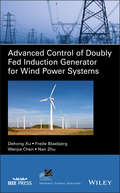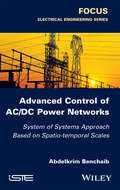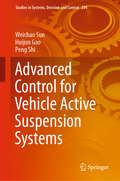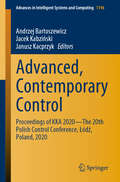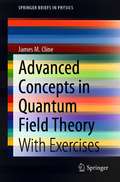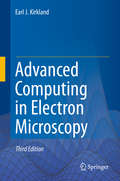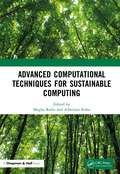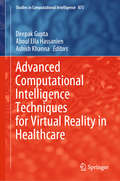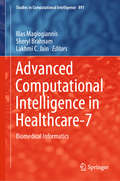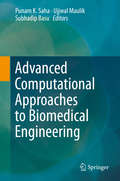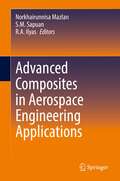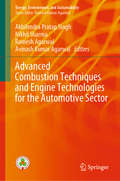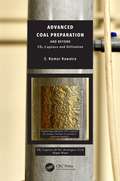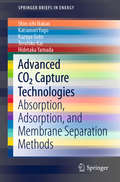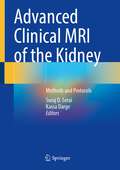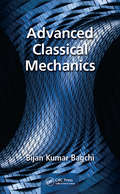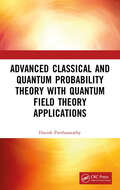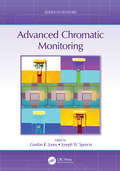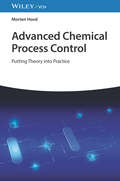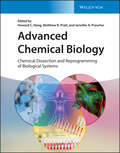- Table View
- List View
Advanced Control of Doubly Fed Induction Generator for Wind Power Systems (IEEE Press Series on Power Engineering)
by Dehong Xu Frede Blaabjerg Wenjie Chen Nan ZhuCovers the fundamental concepts and advanced modelling techniques of Doubly Fed Induction Generators accompanied by analyses and simulation results Filled with illustrations, problems, models, analyses, case studies, selected simulation and experimental results, Advanced Control of Doubly Fed Induction Generator for Wind Power Systems provides the basic concepts for modelling and controlling of Doubly Fed Induction Generator (DFIG) wind power systems and their power converters. It explores both the challenges and concerns of DFIG under a non-ideal grid and introduces the control strategies and effective operations performance options of DFIG under a non-ideal grid. Other topics of this book include thermal analysis of DFIG wind power converters under grid faults; implications of the DFIG test bench; advanced control of DFIG under harmonic distorted grid voltage, including multiple-loop and resonant control; modeling of DFIG and GSC under unbalanced grid voltage; the LFRT of DFIG, including the recurring faults ride through of DFIG; and more. In addition, this resource: Explores the challenges and concerns of Doubly Fed Induction Generators (DFIG) under non-ideal grid Discusses basic concepts of DFIG wind power system and vector control schemes of DFIG Introduces control strategies under a non-ideal grid Includes case studies and simulation and experimental results Advanced Control of Doubly Fed Induction Generator for Wind Power Systems is an ideal book for graduate students studying renewable energy and power electronics as well as for research and development engineers working with wind power converters.
Advanced Control of AC/DC Power Networks
by Abdelkrim BenchaibThe concept of Multi-Terminal DC grids (MTDC), where DC cables connect more than two AC/DC converter stations is nowadays spreading driven by different criteria, all necessaries for large-capacity RES grid integration, such as larger flexibility of grid operation, possibility of reversible power flows, increased redundancy, and reduction of maximum power loss in case of a grid disturbance.
Advanced Control for Vehicle Active Suspension Systems (Studies in Systems, Decision and Control #204)
by Weichao Sun Huijun Gao Peng ShiThis book focuses on most recent theoretical findings on control issues for active suspension systems. The authors first introduce the theoretical background of active suspension control, then present constrained H∞ control approaches of active suspension systems in the entire frequency domain, focusing on the state feedback and dynamic output feedback controller in the finite frequency domain which people are most sensitive to. The book also contains nonlinear constrained tracking control via terminal sliding-mode control and adaptive robust theory, presenting controller design of active suspensions as well as the reliability control of active suspension systems. The target audience primarily comprises research experts in control theory, but the book may also be beneficial for graduate students alike.
Advanced, Contemporary Control: Proceedings of KKA 2020—The 20th Polish Control Conference, Łódź, Poland, 2020 (Advances in Intelligent Systems and Computing #1196)
by Andrzej Bartoszewicz Janusz Kacprzyk Jacek KabzińskiThis book presents the proceedings of the 20th Polish Control Conference. A triennial event that was first held in 1958, the conference successfully combines its long tradition with a modern approach to shed light on problems in control engineering, automation, robotics and a wide range of applications in these disciplines. The book presents new theoretical results concerning the steering of dynamical systems, as well as industrial case studies and worked solutions to real-world problems in contemporary engineering. It particularly focuses on the modelling, identification, analysis and design of automation systems; however, it also addresses the evaluation of their performance, efficiency and reliability. Other topics include fault-tolerant control in robotics, automated manufacturing, mechatronics and industrial systems. Moreover, it discusses data processing and transfer issues, covering a variety of methodologies, including model predictive, robust and adaptive techniques, as well as algebraic and geometric methods, and fractional order calculus approaches. The book also examines essential application areas, such as transportation and autonomous intelligent vehicle systems, robotic arms, mobile manipulators, cyber-physical systems, electric drives and both surface and underwater marine vessels. Lastly, it explores biological and medical applications of the control-theory-inspired methods.
Advanced Concepts in Quantum Mechanics
by Giampiero Esposito Giuseppe Marmo Gennaro Miele George SudarshanIntroducing a geometric view of fundamental physics, starting from quantum mechanics and its experimental foundations, this book is ideal for advanced undergraduate and graduate students in quantum mechanics and mathematical physics. Focusing on structural issues and geometric ideas, this book guides readers from the concepts of classical mechanics to those of quantum mechanics. The book features an original presentation of classical mechanics, with the choice of topics motivated by the subsequent development of quantum mechanics, especially wave equations, Poisson brackets and harmonic oscillators. It also presents new treatments of waves and particles and the symmetries in quantum mechanics, as well as extensive coverage of the experimental foundations.
Advanced Concepts in Quantum Field Theory: With Exercises (SpringerBriefs in Physics)
by James M. ClineThis book comprises the second half of a quantum field theory (QFT) course for graduate students. It gives a concise introduction to advanced concepts that are important for research in elementary particle theory. Topics include the path integral, loop expansion, Feynman rules, various regularization methods, renormalization, running couplings and the renormalization group, fixed points and asymptotic freedom, effective action, Coleman-Weinberg effective potential, fermions, the axial anomaly, QED, gauge fixing, nonabelian gauge theories, unitarity, optical theorem, Slavnov-Taylor identities, beta function of Yang-Mills theory, a heuristic derivation of asymptotic freedom, instantons in SU(N) gauge theory, theta vacua and the strong CP problem. Exercises are included and are intended for advanced graduate students or postdocs seeking to deepen their understanding of QFT.
Advanced Concepts in Particle and Field Theory
by Tristan HübschUniting the usually distinct areas of particle physics and quantum field theory, gravity and general relativity, this expansive and comprehensive textbook of fundamental and theoretical physics describes the quest to consolidate the basic building blocks of nature, by journeying through contemporary discoveries in the field, and analyzing elementary particles and their interactions. Designed for advanced undergraduates and graduate students and abounding in worked examples and detailed derivations, as well as including historical anecdotes and philosophical and methodological perspectives, this textbook provides students with a unified understanding of all matter at the fundamental level. Topics range from gauge principles, particle decay and scattering cross-sections, the Higgs mechanism and mass generation, to spacetime geometries and supersymmetry. By combining historically separate areas of study and presenting them in a logically consistent manner, students will appreciate the underlying similarities and conceptual connections to be made in these fields.
Advanced Computing in Electron Microscopy
by Earl J. KirklandThis updated and revised edition of a classic work provides a summary of methods for numerical computation of high resolution conventional and scanning transmission electron microscope images. At the limits of resolution, image artifacts due to the instrument and the specimen interaction can complicate image interpretation. Image calculations can help the user to interpret and understand high resolution information in recorded electron micrographs. The book contains expanded sections on aberration correction, including a detailed discussion of higher order (multipole) aberrations and their effect on high resolution imaging, new imaging modes such as ABF (annular bright field), and the latest developments in parallel processing using GPUs (graphic processing units), as well as updated references. Beginning and experienced users at the advanced undergraduate or graduate level will find the book to be a unique and essential guide to the theory and methods of computation in electron microscopy.
Advanced Computational Vibroacoustics
by Roger OhayonAdvanced Computational Vibroacoustics presents an advanced computational method for the prediction of sound and structural vibrations, in low- and medium-frequency ranges - complex structural acoustics and fluid-structure interaction systems encountered in aerospace, automotive, railway, naval, and energy-production industries. The formulations are presented within a unified computational strategy and are adapted for the present and future generation of massively parallel computers. A reduced-order computational model is constructed using the finite element method for the damped structure and the dissipative internal acoustic fluid (gas or liquid with or without free surface) and using an appropriate symmetric boundary-element method for the external acoustic fluid (gas or liquid). This book allows direct access to computational methods that have been adapted for the future evolution of general commercial software. Written for the global market, it is an invaluable resource for academic researchers, graduate students, and practising engineers.
Advanced Computational Techniques for Sustainable Computing
by Megha RathiAdvanced Computational Techniques for Sustainable Computing is considered multi-disciplinary field encompassing advanced computational techniques across several domain, including, Computer Science, Statistical Computation and Electronics Engineering. The core idea of sustainable computing is to deploy algorithms, models, policies and protocols to improve energy efficiency and management of resources, enhancing ecological balance, biological sustenance and other services on societal contexts. The book offers comprehensive coverage of the most essential topics, and: Provides insight on building smart sustainable solutions Includes details of applying mining, learning, IOT and sensor-based techniques for sustainable computing Entails data extraction from various sources followed with pre-processing of data, and how to make effective use of extracted data for application-based research Involves practical usage of data analytic language, including R, Python, etc. for improving sustainable services offered by multi-disciplinary domains Encompasses comparison and analysis of recent technologies and trends Includes development of smart models for information gain and effective decision making with visualization The readers would get acquainted with the utilization of massive data sets for intelligent mining and processing. It includes the integration of data mining techniques for effective decision-making in the social, economic, and global environmental domains to achieve sustainability. The implementation of computational frameworks can be accomplished using open-source software for the building of resource-efficient models. The content of the book demonstrates the usage of data science and the internet of things for the advent of smart and realistic solutions for attaining sustainability.
Advanced Computational Intelligence Techniques for Virtual Reality in Healthcare (Studies in Computational Intelligence #875)
by Aboul Ella Hassanien Deepak Gupta Ashish KhannaThis book addresses the difficult task of integrating computational techniques with virtual reality and healthcare. It discusses the use of virtual reality in various areas, such as healthcare, cognitive and behavioural training, understanding mathematical graphs, human–computer interaction, fluid dynamics in healthcare industries, accurate real-time simulation, and healthcare diagnostics.Presenting the computational techniques for virtual reality in healthcare, it is a valuable reference resource for professionals at educational institutes as well as researchers, scientists, engineers and practitioners in industry.
Advanced Computational Intelligence in Healthcare-7: Biomedical Informatics (Studies in Computational Intelligence #891)
by Lakhmi C. Jain Sheryl Brahnam Ilias MaglogiannisThis book presents state-of-the-art works and systematic reviews in the emerging field of computational intelligence (CI) in electronic health care. The respective chapters present surveys and practical examples of artificial intelligence applications in the areas of Human-Machine Interface (HMI) and affective computing, machine learning, big health data and visualization analytics, computer vision and medical image analysis. The book also addresses new and emerging topics in CI for health care such as the utilization of Social Media (SM) and the introduction of new intelligent paradigms in the security and privacy domains, which are critical for the health sector. The chapters, while of course not exhaustively addressing all the possible aspects of the aforementioned areas, are indicative of the dynamic nature of interdisciplinary research being pursued. Accordingly, the book is intended not only for researchers in the respective fields, but also for medical and administrative personnel working in the health sector, as well as managers and stakeholders responsible for making strategic decisions and defining public health policies.
Advanced Computational Fluid and Aerodynamics
by Tucker Paul G.The advent of supercomputers has brought computational fluid dynamics (CFD) to the forefront as a tool to analyze increasingly complex simulation scenarios in many fields. Computational aerodynamics problems are also increasingly moving towards being coupled, multi-physics and multi-scale with complex, moving geometries. The latter presents severe geometry handling and meshing challenges. Simulations also frequently use formal design optimization processes. This book explains the evolution of CFD and provides a comprehensive overview of the plethora of tools and methods available for solving complex scenarios while exploring the future directions and possible outcomes. Using numerous examples, illustrations and computational methods the author discusses turbulence modeling, pre and post processing, coupled solutions, the importance of design optimization, multiphysics problems, reduced order models, and large scale computations and the future of CFD. Advanced Computational Fluid and Aerodynamics is suitable for audiences engaged in computational fluid dynamics including advanced undergraduates, researchers and industrial practitioners.
Advanced Computational Approaches to Biomedical Engineering
by Ujjwal Maulik Punam K. Saha Subhadip BasuThere has been rapid growth in biomedical engineering in recent decades, given advancements in medical imaging and physiological modelling and sensing systems, coupled with immense growth in computational and network technology, analytic approaches, visualization and virtual-reality, man-machine interaction and automation. Biomedical engineering involves applying engineering principles to the medical and biological sciences and it comprises several topics including biomedicine, medical imaging, physiological modelling and sensing, instrumentation, real-time systems, automation and control, signal processing, image reconstruction, processing and analysis, pattern recognition, and biomechanics. It holds great promise for the diagnosis and treatment of complex medical conditions, in particular, as we can now target direct clinical applications, research and development in biomedical engineering is helping us to develop innovative implants and prosthetics, create new medical imaging technologies and improve tools and techniques for the detection, prevention and treatment of diseases. The contributing authors in this edited book present representative surveys of advances in their respective fields, focusing in particular on techniques for the analysis of complex biomedical data. The book will be a useful reference for graduate students, researchers and industrial practitioners in computer science, biomedical engineering, and computational and molecular biology.
Advanced Composites in Aerospace Engineering Applications
by S. M. Sapuan R. A. Ilyas Norkhairunnisa MazlanThis book presents an authoritative account of the potential of advanced composites such as composites, biocomposites, composites geopolymer, hybrid composites and hybrid biocomposites in aerospace application. It documents how in recent years, composite materials have grown in strength, stature, and significance to become a key material of enhanced scientific interest and resultant research into understanding their behavior for selection and safe use in a wide spectrum of technology-related applications. This collection highlights how their unique combination of superior properties such as low density, high strength, high elastic modulus, high hardness, high temperature capability, and excellent chemical and environmental stability are optimized in technologies within these field.
Advanced Combustion Techniques and Engine Technologies for the Automotive Sector (Energy, Environment, and Sustainability)
by Akhilendra Pratap Singh Nikhil Sharma Ramesh Agarwal Avinash Kumar AgarwalThis book discusses the recent advances in combustion strategies and engine technologies, with specific reference to the automotive sector. Chapters discuss the advanced combustion technologies, such as gasoline direct ignition (GDI), spark assisted compression ignition (SACI), gasoline compression ignition (GCI), etc., which are the future of the automotive sector. Emphasis is given to technologies which have the potential for utilization of alternative fuels as well as emission reduction. One special section includes a few chapters for methanol utilization in two-wheelers and four wheelers. The book will serve as a valuable resource for academic researchers and professional automotive engineers alike.
Advanced Coal Preparation and Beyond: CO2 Capture and Utilization
by S. Komar KawatraUpdating content from the author’s 2001 book Coal Desulfurization, this new title focuses on CO2 sequestration and utilization. It includes information on the theory and practical approaches to CO2 capture and recent advances in the use of sequestered CO2. Avoiding these pollutants requires either forgetting about the 250 billion tons of coal reserves the United States possesses or capturing and utilizing the pollutants in a profitable and environmentally responsible fashion. The book covers postcombustion and precombustion capture approaches for coal, and postcombustion capture can be generalized to many other fuels. Recent practical implementations at full-scale power facilities around the world are discussed. The book covers sequestering CO2 via underground, oceanic, biological, and other long-term CO2 storage methods. It also includes recent advances in utilizing CO2 for enhanced oil recovery, advances in storage with depleted oil and gas reservoirs and deep saline aquifers, and additional topics. The book also examines specific applications of pure CO2 and covers chemical conversion of CO2 to useful compounds. It answers questions like "Can we create methanol from coal?" or "Can we create ethanol from coal?" It is found that methanol and ethanol cannot be sustainably produced from coal power alone. However, oxalic acid can be created at a much lower energy cost than methanol or ethanol. Oxalic acid can be used to extract rare earths, which are not currently produced anywhere in the United States, but are typically concentrated in coal ash. Aimed at researchers and industry professionals in chemical, environmental, and energy engineering, this book provides insight and inspiration into capturing CO2 not merely as a response to regulatory pressure and climate change but as an inherently profitable and valuable venture.
Advanced CO2 Capture Technologies: Absorption, Adsorption, and Membrane Separation Methods (SpringerBriefs in Energy)
by Shin-ichi Nakao Katsunori Yogo Kazuya Goto Teruhiko Kai Hidetaka YamadaThis book summarises the advanced CO2 capture technologies that can be used to reduce greenhouse gas emissions, especially those from large-scale sources, such as power-generation and steel-making plants. Focusing on the fundamental chemistry and chemical processes, as well as advanced technologies, including absorption and adsorption, it also discusses other aspects of the major CO2 capture methods: membrane separation; the basic chemistry and process for CO2 capture; the development of materials and processes; and practical applications, based on the authors’ R&D experience. This book serves as a valuable reference resource for researchers, teachers and students interested in CO2 problems, providing essential information on how to capture CO2 from various types of gases efficiently. It is also of interest to practitioners and academics, as it discusses the performance of the latest technologies applied in large-scale emission sources.
Advanced Clinical MRI of the Kidney: Methods and Protocols
by Suraj D. Serai Kassa DargeThis book offers the concepts of quantitative MRI for kidney imaging. Kidney MRI holds incredible promise for making a quantum leap in improving diagnosis and care of patients with a multitude of diseases, by moving beyond the limitations and restrictions of current routine clinical practice. Clinical kidney MRI is advancing with ever increasing rapidity, and yet, it is still not good enough. Several roadblocks still slow the pace of progress, particularly inefficient education of renal MR researchers, and lack of harmonization of approaches that limits the sharing of results among multiple research groups.With the help of this book, we aim to address these limitations, by providing a comprehensive collection of more chapters on MRI methods that serve as a foundational resource for clinical kidney MRI studies. This includes chapters describing the fundamental principles underlying a variety of kidney MRI methods, step-by-step protocols for executing kidney MRI studies, and detailed guides for post-processing and data analysis. This collection serves as a crucial part of a roadmap towards conducting kidney MRI studies in a robust and reproducible way, that promotes the standardization and sharing of data, and ultimately, clinical translation.Chapters are divided into three parts: MRI physics and acquisition protocols, post-processing and data analysis methods, and clinical applications. The first section includes MRI physics background and describe a detailed step by step MRI acquisition protocol. If a clinician would like to perform a renal MRI – this would include the parameters to set up the acquisition on the scanner. By this section, the reader should have the details to be able to successfully collect human renal MR images. In the second section, expert authors describe methods on how to post-process and analyze the data. By this section, the reader should have the details to be able to successfully generate quantitative data from the human renal MR images. In the final section, chapters show clinical examples of various methods. Authors share examples of multi-parametric renal MRI that are being used in clinical practice.This is an ideal guide for clinicians from radiology, nephrology, physiology, clinical scientists, and as well as basic scientists and experts in imaging sciences and physics of kidney MRI. It also provides an opportunity to students, trainees, and post-doctoral fellows to learn about these kidney MRI techniques.
Advanced Classical Mechanics
by Bijan BagchiThis book is designed to serve as a textbook for postgraduates, researchers of applied mathematics, theoretical physics and students of engineering who need a good understanding of classical mechanics. In this book emphasis has been placed on the logical ordering of topics and appropriate formulation of the key mathematical equations with a view to imparting a clear idea of the basic tools of the subject and improving the problem solving skills of the students. The book provides a largely self-contained exposition to the topics with new ideas as a smooth continuation of the preceding ones. It is expected to give a systematic and comprehensive coverage of the methods of classical mechanics.
Advanced Classical and Quantum Probability Theory with Quantum Field Theory Applications
by Harish ParthasarathyThis book is based on three undergraduate and postgraduate courses taught by the author on Matrix theory, Probability theory and Antenna theory over the past several years. It discusses Matrix theory, Probability theory and Antenna theory with solved problems. It will be useful to undergraduate and postgraduate students of Electronics and Communications Engineering. Print edition not for sale in South Asia (India, Sri Lanka, Nepal, Bangladesh, Pakistan and Bhutan).
Advanced Chromatic Monitoring (Series in Sensors)
by Gordon R. Jones and Joseph W. SpencerAdvanced Chromatic Monitoring provides a major source of information about the novel approach of chromaticity with examples of how chromaticity may be deployed for various monitoring applications. It shows with examples what can be achieved with chromatic methods in producing relevant information with a variety of test techniques and in facilitating the interpretation of complex data about complicated situations. It will be of interest to postgraduates and researchers in a wide breadth of physical disciplines (engineering, medicine, environmental sciences) and those involved with data acquisition and analysis. Key Features: Applicable to a wide range of disciplines (engineering, medical, environmental, etc) and those interested in science, technology, data acquisition and analysis Provides an extrapolation of new knowledge well beyond that covered in existing literature with regard to dealing with complicated forms and sets of data Addresses inspiring and innovative areas of research including environmental, power delivery and medical monitoring About the Editors: Emeritus Professor Gordon R. Jones – founder and former Director of the Centre for Intelligent Monitoring Systems (CIMS), former Head of the Department of Electrical Engineering and Electronics, and former Director of Electric Arcs Research Group at the University of Liverpool. He was awarded the IEEE Education, Science and Technology Achievement Medal (1999). Professor Joe W. Spencer – the present Director of CIMS at the University of Liverpool, having been Head of the Department of Electrical Engineering and Electronics at Liverpool. He is involved in operating a multi-million pound technology transfer unit (Sensor City, Liverpool) with whose establishment he played a major role and with which CIMS has major interactions.
Advanced Chemistry in Creation (2nd Edition)
by Jay L. WileYou are about to embark upon an amazing journey! In this text, you will take a deep look at the fascinating subject of chemistry. You will learn about the matter that makes up God's creation and how it changes. Although this course will be hard work, you will learn some truly incredible things.
Advanced Chemical Process Control: Putting Theory into Practice
by Morten HovdAdvanced Chemical Process Control Bridge the gap between theory and practice with this accessible guide Process control is an area of study which seeks to optimize industrial processes, applying different strategies and technologies as required to navigate the variety of processes and their many potential challenges. Though the body of chemical process control theory is robust, it is only in recent decades that it has been effectively integrated with industrial practice to form a flexible toolkit. The need for a guide to this integration of theory and practice has therefore never been more urgent. Advanced Chemical Process Control meets this need, making advanced chemical process control accessible and useful to chemical engineers with little grounding in the theoretical principles of the subject. It provides a basic introduction to the background and mathematics of control theory, before turning to the implementation of control principles in industrial contexts. The result is a bridge between the insights of control theory and the needs of engineers in plants, factories, research facilities, and beyond. Advanced Chemical Process Control readers will also find: Detailed overview of Control Performance Monitoring (CPM), Model Predictive Control (MPC), and more Discussion of the cost benefit analysis of improved control in particular jobs Authored by a leading international expert on chemical process control Advanced Chemical Process Control is essential for chemical and process engineers looking to develop a working knowledge of process control, as well as for students and graduates entering the chemical process control field.
Advanced Chemical Biology: Chemical Dissection and Reprogramming of Biological Systems
by Howard HangAdvanced Chemical Biology The modern approach to teaching chemical biology Advanced Chemical Biology is organized around the central dogma of life, progressing from genes to proteins and higher-order cellular structures, including core application areas such as imaging, chemical genetics, activity-based protein profiling, and natural product discovery and biosynthesis. Advanced topics and applications in, e. g., microbiology, developmental biology, and neurobiology, are covered in separate sections. Every chapter is homogeneous in style and layout, consisting of a short historical introduction followed by a description of the underlying concepts and a selection of recent examples of how the concept has been turned into practice. The subdivision of the contents into core and supplemental chapters enables a flexible use in teaching, both for a one-semester and a two-semester course. Written by authors and editors coming from the leading scientific institutions that have developed the concepts and technologies for this discipline, Advanced Chemical Biology includes specific information on topics like: DNA function, synthesis and engineering, chemical approaches to genome integrity, and RNA function, synthesis, and probing Chemical approaches to transcription and RNA regulation in vivo, chemical biology of genome engineering, and peptide/protein synthesis and engineering Directed evolution for chemical biology, chemical biology of cellular metabolism, chemical biology of lipids, and protein post-translational modifications Chemical glycobiology, chemical and enzymatic modification of proteins, genetic code expansion, bio-orthogonal chemistry, and cellular imaging With its broad scope and focus on turning concepts into applications, Advanced Chemical Biology is an excellent starting point for anyone entering the field and looking for a guide to the wide range of available methods and strategies that chemical biology has to offer. With a Foreword by Nobel Laureate Carolyn Bertozzi.
